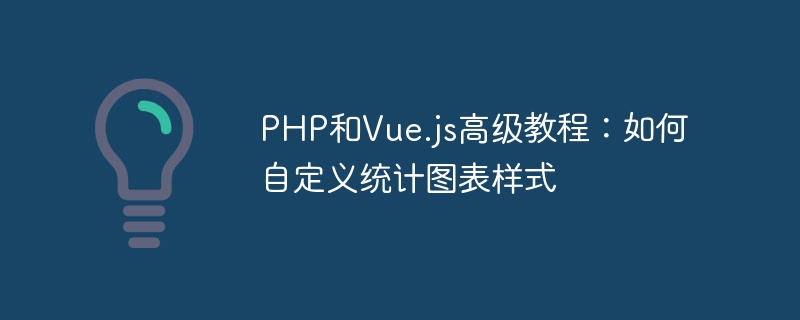

PHP and Vue.js Advanced Tutorial: How to Customize Statistical Chart Styles
In web development, statistical charts are one of the important tools for displaying data. Many developers use PHP and Vue.js to build dynamic and interactive charts. This tutorial will introduce how to customize statistical chart styles using PHP and Vue.js.
1. Preparation
Before you start, make sure you have installed PHP and Vue.js and understand the basic PHP and Vue.js syntax. In addition, you also need an API that can obtain data, such as querying data from a database through PHP. In this tutorial, we will use getting order data from the database as an example.
2. Install and configure Chart.js
Chart.js is a popular JavaScript library used to create various types of charts. First, you need to install Chart.js in your project. You can download it from the official website (https://www.chartjs.org/) and add it to your project, or install it using a package management tool such as npm or yarn.
Then, introduce Chart.js into your Vue.js component:
import Chart from 'chart.js';
Next, we need to define a method for initializing the chart:
methods: {
initChart() {
const ctx = document.getElementById('myChart');
const myChart = new Chart(ctx, {
type: 'bar',
data: {
labels: [],
datasets: [{
label: '订单数量',
data: [],
backgroundColor: [],
borderColor: [],
borderWidth: 1
}]
},
options: {
responsive: true,
maintainAspectRatio: false
}
});
}
},In In the above code, we create a new Chart instance and bind it to the specified canvas element (id is myChart). We also define the chart type as a bar chart, the data as empty, and some custom options. You can adjust it according to your needs.
Next, we need to fetch the data and update the chart. You can add the following code to the created hook function of your Vue.js component:
created() {
this.initChart();
this.fetchData();
},
methods: {
fetchData() {
// 通过PHP获取数据,这里假设我们有一个名为getOrders的API
axios.get('/api/getOrders')
.then(response => {
const orders = response.data;
// 更新图表的数据和样式
this.updateChart(orders);
})
.catch(error => {
console.error(error);
});
},
updateChart(orders) {
const labels = orders.map(order => order.date);
const data = orders.map(order => order.quantity);
const backgroundColor = orders.map(() => '#0066ff');
const borderColor = orders.map(() => '#0044cc');
this.myChart.data.labels = labels;
this.myChart.data.datasets[0].data = data;
this.myChart.data.datasets[0].backgroundColor = backgroundColor;
this.myChart.data.datasets[0].borderColor = borderColor;
this.myChart.update();
}
}In the above code, we use the axios library to send HTTP requests and get the order data in the database. Then, we extract data such as date, quantity, etc., and update the data and style of the chart. You can adapt it to your own data structure and styling needs.
3. Customized styles
In addition to the basic data styles, you can also customize the chart styles, such as titles, axis labels, colors, fonts, etc. The following are some common customization methods:
options: {
title: {
display: true,
text: '销售订单统计',
fontColor: '#333',
fontSize: 18,
fontStyle: 'bold'
}
}options: {
scales: {
yAxes: [{
ticks: {
fontColor: '#666',
fontSize: 12
}
}],
xAxes: [{
ticks: {
fontColor: '#666',
fontSize: 12
}
}]
}
}datasets: [{
label: '订单数量',
data: [],
backgroundColor: '#0066ff',
borderColor: '#0044cc'
}]Chart.defaults.global.defaultFontFamily = 'Arial';
4. Summary
Through this tutorial, you have learned how to use PHP and Vue.js to customize the style of statistical charts. You learned how to configure Chart.js and initialize the chart, then use PHP to get data from the database and update the chart. Additionally, you learned how to customize styles such as titles, axis labels, colors, and fonts.
Please remember that in actual development, you can perform more style customization according to your project needs and personal style. I hope this tutorial will be helpful to your learning and practice!
The above is the detailed content of PHP and Vue.js Advanced Tutorial: How to Customize Statistical Chart Styles. For more information, please follow other related articles on the PHP Chinese website!